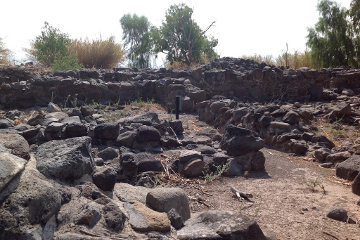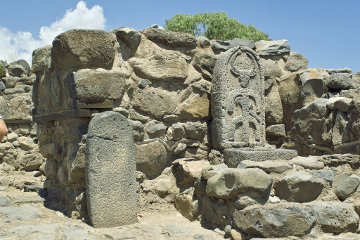Is Bethsaida Julias?
| Bethsaida/Julias | 32 54 36.98N 65 37 50.19E | The tel is covered with trees and nothing is visible of either new or old excavations. |
| Capernaum | 32 52 51.65N 35 34 31.37E | The coordinates of the White Synagogue. |
| Mystery Tel | 32 51 54.16N 35 32 13.84E | Look beyond the front of the green pickup truck to see the tel. You can also see the shadow of the man carrying the Google camera! |
There is news in the press this week that archaeologists in Israel have identified Bethsaida, home of three of Jesus' disciples. The excavations are being run by the Institute for Galilean Archaeology, directed by Dr Mordechai Aviam, and Nyack College, New York, under Dr Steven Notley, the academic director for the work.

| |
| The House of the Fisherman in Bethsaida. A large quantity of fishing equipment was found in the building. |
I was slightly surprised by this announcement, as several years ago I visited Bethsaida and walked around its ruins. A closer reading of the article, however, reveals that it is not Bethsaida that has been discovered but Julias, a town built on the same site as Bethsaida. Although details are still sparse, this is not all that surprising. The Bethsaida I visited was on the summit of a low tel and while it is not impossible that the Romans might build in such a position, the analogy of Beth Shan would indicate that the Romans built in the plain below the tel, where they would have room for amenities such as an large forum, baths, a theatre and so on.
When I say "the Romans", in fact Julias was built by Herod Philip, known as the Tetrarch. He may well have employed Roman architects and engineers and used Roman ideas of town planning, but the impetus for building the town came from him. Josephus tells us:
He advanced the village Bethsaida, situate at the Lake of Gennesareth, unto the dignity of a city, both by the number of inhabitants it contained, and its other grandeur, and called it by the name of Julias, the same name with Caesar's daughter."
Antiquities of the Jews XVIII, 2.1
Curiously, Herod Philip seems to have been fond of the name, for he called another of his rebuildings after Caesar's wife, another Julia.
He also built a wall round Betharamphtha, which was itself a city also, and called it Julias, from the name of the emperor's wife.
Antiquities of the Jews XVIII, 2.1
It is clear that Josephus was under the impression that the Caesar in question was Augustus, which poses a bit of a problem. Herod Philip was born around 19 BC and was given his tetrarchy after the death of his father, Herod the Great, in 4 BC. That means that he was only about fifteen, rather young to be thinking of such an extensive programme of building.

| |
| This appears to be the main gateway into Bethsaida, though I am not clear about the age of the gate. |
However unless he started his building work immediately - and more or less finished it in very short order - it is unlikely that he would have called his city after Augustus' daughter Julia!
In 40 BC Octavian - as he then was - made an alliance with Lucius Scribonius Libo, a close ally and father-in-law of Sextus Pompeius, the son of Pompey. The alliance was sealed by Octavian marrying Lucius' daughter, Scribonia. A week, so we are told, is a long time in politics and a year is even longer. Just slightly longer than a year after his marriage, Octavian divorced Scribonia and married Livia Drusilla instead. On the same day Scribonia gave birth to a daughter, Octavian's only natural child, to whom one of them gave the name Julia.
After several marriages, Julia was married by Octavian - now known as Augustus - to his step-son Tiberius, the son of Livia Drusilla, at the same time forcing him to divorce Vipsania Agrippina, whom he dearly loved. The marriage only lasted for five years: Tiberius bitterly resented poor Julia - her feelings in the matter are not recorded - and took himself off to Rhodes in 6 BC.

| |
| These stele seem to date from well before the time of Christ - but are they in situ or have they been moved? |
Left at home, poor Julia fell an easy prety to a series of men who desired her beauty (and, no doubt, the possibility of influence through her connection with Augustus). In 2 BC word of these affairs reached Augustus who, as her father, had complete rights over her. He promptly arranged for Tiberius to repudiate her and then had her arrested and sent into exile on the island of Pandateria, where she was kept secluded from all men, not allowed any visitors at all and not even permitted to drink wine. Her only comfort was that her mother, Scribonia, was allowed to go with her.
(To complete the poor woman's story, no sooner was Tiberius on the throne than he arranged for Julia to be starved to death. It's as good as a soap opera!)
If Herod Philip ascended the throne in 4 BC and Julia was disgraced and exiled in 2 BC, it is highly unlikely that he would have risked the wrath of Augustus by calling his new city after Caesar's daughter - or if he had, that he would keep the name and not hastily rename the town! It seems obvious to me that Josephus got it wrong.
However it is not beyond the bounds of possibility that Herod Philip named both places after Augustus' wife, in which case they must have been completed after AD 14, for that was the year in which Livia Drusilla took the name Julia Augusta after she was formally adopted by the Julian family. This is a much more likely timescale for such an ambitious building programme, for Herod Philip was only a Tetrarch and could not command the huge resources that would be required to build a complete city in less than two years.
The newly discovered remains will not be open to the public for some time, as work is on-going. This is no great loss, as so far all that has been found is pottery and coins from the right period and the remains of a bath house. That is little enough for what seems to have been Herod Philip's favourite residence, for he died and was buried there.
There is some question, though, whether this Bethsaida is the Bethsaida of the gospels. The question is discussed at some length in an article by Tony Benson, which those interested may wish to read. Mr Benson's conclusion - that there is a second Bethsaida only a short distance from Capernaum - is not impossible, but is, in my opinion, unlikely.
He claims that if the Lake of Galilee reached as far as Bethsaida/Julias it would have drowned Capernaum. While that is doubtless true of the present-day geography, it is not impossible that there may have been earth movements that uplifted the northern end of the Lake of Galilee. Signs at the site of Bethsaida/Julias claim that in the time of Jesus the area was a marsh rather than lake-side.
If so, it would dispose of another of Mr Benson's comments, which is that it would be strange for fishermen from Bethsaida to be apparently at home in Capernaum where Jesus met them. If they could not sail their boats up to Bethsaida, what more natural than that they should mend their nets and make themselves at home elsewhere?
Finally, from Capernaum to Bethsaida/Julias is only four miles. It seems to me most unlikely that there would be two villages called Bethsaida so close together without them being distinguished by some cognomen such as "Bethsaid-in-Trachonitis".
On the other hand, south of Capernaum there is a very clear tel visible from the road, about which I have never been able to find out anything. The coordinates given above for the "Mystery Tel" are not, in fact, for the tel itself but for the nearby road. If you go into Street View from Google Earth and turn so that you are looking beyond the front of the dark green pickup truck parked beside the road, you will be able to see the mound in question. You will also see on the road the shadow of someone wearing the Google Camera outfit, which is why, if you look a little further north, you will find Street View clambering over some very knobbly rocks beside a security fence! I wonder if this unnamed tel could be Benson's second Bethsaida?
© Kendall K. Down 2017





